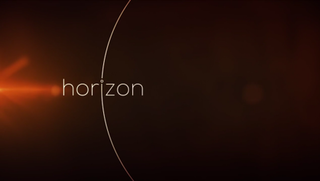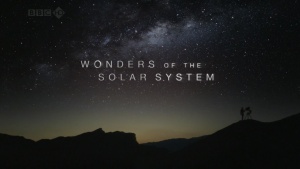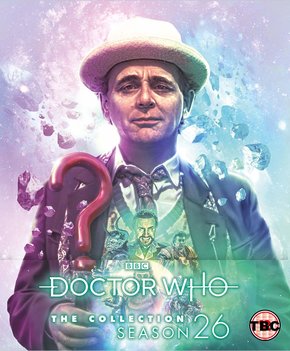
Horizon is an ongoing and long-running British documentary television series on BBC Two that covers science and philosophy.

"Galaxy Song" is a Monty Python song written by Eric Idle and John Du Prez.

Brian Edward Cox is an English physicist and musician who is professor of particle physics in the School of Physics and Astronomy at the University of Manchester and the Royal Society Professor for Public Engagement in Science. He is best known to the public as the presenter of science programmes, especially BBC Radio 4’s The Infinite Monkey Cage and the Wonders of... series and for popular science books, such as Why Does E=mc2? and The Quantum Universe.

Nature's Great Events is a wildlife documentary series made for BBC television, first shown in the UK on BBC One and BBC HD in February 2009. The series looks at how seasonal changes powered by the sun cause shifting weather patterns and ocean currents, which in turn create the conditions for some of the planet's most spectacular wildlife events. Each episode focuses on the challenges and opportunities these changes present to a few key species.

Defying Gravity is a multi-nationally produced science fiction television series which first aired on August 2, 2009 on ABC and CTV and was canceled in October 2009. Set in the year 2052, the series follows eight astronauts from four countries on a six-year space mission through the Solar System, during which they are monitored from Earth via a real-time communication system. The series was pitched to networks as "Grey's Anatomy in space". Thirteen episodes of the series were produced before it was cancelled, only eight of which were shown on ABC, though the full run was shown in other countries or online.

How the Earth Was Made is a documentary television series produced by Pioneer Productions for the History Channel. It began as a two-hour special exploring the geological history of Earth, airing on December 16, 2007. Focusing on different geologic features of the Earth, the series premiered on February 10, 2009, and the 13-episode first season concluded on May 5, 2009. The second season premiered on November 24, 2009, and concluded on March 2, 2010.

Human Planet is an 8-part British television documentary series. It was produced as a co-production between the BBC Natural History Unit, BBC Worldwide, BBC Cymru Wales, Discovery Channel and France Télévisions. The documentary describes the human species and its relationship with the natural world by showing the remarkable ways humans have adapted to life in every environment on Earth. The show drew attention for alleged fakery and the BBC eventually acknowledged that a number of scenes were inaccurately depicted or misleading and withdrew the series from distribution.

The Symphony of Science is a music project created by Washington-based electronic musician John D. Boswell. The project seeks to "spread scientific knowledge and philosophy through musical remixes." Boswell uses pitch-corrected audio and video samples from television programs featuring popular educators and scientists. The audio and video clips are mixed into digital mashups and scored with Boswell's original compositions. Two of Boswell's music videos, "A Glorious Dawn" and "We are All Connected", feature appearances from Carl Sagan, Richard Feynman, Neil deGrasse Tyson, Bill Nye, and Stephen Hawking. The audio and video is sampled from popular science television shows including Cosmos, The Universe, The Eyes of Nye, The Elegant Universe, and Stephen Hawking's Universe.

Wonders of the Solar System is a 2010 television series co-produced by the BBC and Science Channel, and hosted by physicist Brian Cox. Wonders of the Solar System was first broadcast in the United Kingdom on BBC Two on 7 March 2010. The series comprises five episodes, each of which focuses on an aspect of the Solar System and features a 'wonder' relevant to the theme. The series was described as one of the most successful to appear on BBC Two in recent years. An accompanying book with the same name was also published.
Stargazing Live is a British live television programme on astronomy that was broadcast yearly on BBC Two over three nights every winter from 2011 to 2017. The series was primarily presented by scientist Brian Cox and comedian and amateur astronomer Dara Ó Briain with support from TV presenter and biochemist Liz Bonnin and astronomer Mark Thompson. For the first six series, the show was broadcast from Jodrell Bank Observatory in Cheshire, and featured live links from scientific facilities in locations such as Hawaii, South Africa, and Norway. The seventh series in 2017 was broadcast from Siding Spring Observatory in Australia, and a special episode filmed at Kennedy Space Center was broadcast in July 2019 to celebrate the 50th anniversary of the Apollo 11 mission.

The 26th season of Doctor Who premiered on 6 September 1989 with the serial "Battlefield," and consisted of four serials, ending with "Survival," which was the final episode of Doctor Who for over 15 years, until the show was revived in 2005. John Nathan-Turner produced the series, with Andrew Cartmel script editing.

The twenty-fifth season of British science fiction television series Doctor Who began on 5 October 1988. It comprised four separate serials, beginning with Remembrance of the Daleks and ending with The Greatest Show in the Galaxy. To mark the 25th anniversary season, producer John Nathan-Turner brought back the Daleks and the Cybermen. The American New Jersey Network also made a special behind-the-scenes documentary called The Making of Doctor Who, which followed the production of the 25th anniversary story Silver Nemesis. Andrew Cartmel script edited the series.

Wonders of Life is a 2013 television documentary series presented by physicist Brian Cox. The series was produced by the BBC and Chinese state television network CCTV-9 and aired in the United Kingdom from 27 January 2013 at 9:00 pm on BBC Two. An accompanying book with the same title was also published.

The 2013 specials of the British science fiction television programme Doctor Who are two additional episodes following the programme's seventh series. In addition to the traditional Christmas episode broadcast on 25 December 2013, a feature of the revived series since 2005, there was also a special celebrating the 50th anniversary of the programme broadcast on 23 November 2013, both airing on BBC One.

Human Universe is a British television series broadcast on BBC Two, presented by Professor Brian Cox. An accompanying book was also published.

Life Story is a British natural-history television series co-produced by the BBC Natural History Unit, Discovery Channel and France Télévisions in association with The Open University. The six-part series, narrated by David Attenborough, reveals the challenges faced by individual animals at different stages of their lives.

The Hunt is a 2015 British nature documentary series made for BBC Television, first shown in the UK on BBC One and BBC One HD on 1 November 2015. The series is narrated by David Attenborough.

Planet Earth II is a 2016 British nature documentary series co-produced by the BBC Natural History Unit, BBC Studios, BBC America, ZDF, France Télévisions and Tencent and distributed by BBC Worldwide. It functions as a sequel to Planet Earth, which was broadcast in 2006. The series is presented and narrated by Sir David Attenborough with the main theme music composed by Hans Zimmer.
Wonders of the Monsoon is a BBC documentary series which ran for five episodes between 5 October 2014 and 2 November 2014, and aired on BBC Two. The series focus for a variety of locations around the world features including India, Australia and islands of the Pacific Ocean which are all the focus of the monsoon rains.

















